Jacob Lawrence and his Artwork, Boston restores monument to Black Civil War troops, PBS News, and Wikipedia
With a history of abuse in American medicine, Black patients struggle for equal access, Feb 24, 2021 PBS NewsHour
Boston restores monument to Black Civil War troops, Feb 24, 2021 PBS NewsHour
During Black History Month, students reflect on their modern-day heroes, Feb 24, 2021 PBS NewsHour
In ‘Grief and Grievance,’ Black artists explore aspects of loss in contemporary life, Mar 17, 2021 PBS NewsHour
PBS NewsHour full episode, Feb. 24, 2021, Feb 24, 2021 PBS NewsHour
How the economic relief law narrows the equity gap for farmers of color, Mar 16, 2021 PBS NewsHour
Jacob Lawrence: From Wikipedia, the free encyclopedia
Jacob Lawrence and his Artwork
With a history of abuse in American medicine, Black patients struggle for equal access
Feb 24, 2021 PBS NewsHour
Black Americans have historically faced discrimination and even abuse by medical professionals, issues that have again come to the forefront during the pandemic. We here from Americans who have directly experienced discrimination, and Yamiche Alcindor speaks with Dr. Vanessa Northington Gamble, a professor of medical humanities at George Washington University, to discuss this painful legacy. Stream your PBS favorites with the PBS app: https://to.pbs.org/2Jb8twG? Find more from PBS NewsHour at https://www.pbs.org/newshour? Subscribe to our YouTube channel: https://bit.ly/2HfsCD6?
Boston restores monument to Black Civil War troops
Feb 24, 2021 PBS NewsHour
In a time when statues and monuments around the country are being removed for what they represent, the Shaw Memorial in Boston is receiving attention of a different sort. It is being fully restored, with pride that the monument depicting Black soldiers marching off to battle in the civil war, stands the test of time. Special correspondent Jared Bowen of GBH Boston reports. Stream your PBS favorites with the PBS app: https://to.pbs.org/2Jb8twG? Find more from PBS NewsHour at https://www.pbs.org/newshour? Subscribe to our YouTube channel: https://bit.ly/2HfsCD6
During Black History Month, students reflect on their modern-day heroes
Feb 24, 2021 PBS NewsHour
Black History Month expands students’ understanding of the Black experience in American history. But one teacher in Akron, Ohio wanted her students to see that Black history isn’t something that happened in the past, it happens every single day through each of them. She worked with our Student Reporting Labs program to record these reflections from students. Stream your PBS favorites with the PBS app: https://to.pbs.org/2Jb8twG? Find more from PBS NewsHour at https://www.pbs.org/newshour? Subscribe to our YouTube channel: https://bit.ly/2HfsCD6? Follow us: Facebook: http://www.pbs.org/newshour? Twitter: http://www.twitter.com/newshour? Instagram: http://www.instagram.com/newshour? Subscribe: PBS NewsHour podcasts: https://www.pbs.org/newshour/podcasts? Newsletters: https://www.pbs.org/newshour/subscribe?
In ‘Grief and Grievance,’ Black artists explore aspects of loss in contemporary life
Mar 17, 2021 PBS NewsHour
Even amid the pandemic, some art exhibitions are opening to the public. “Grief and Grievance” at New York’s “New Museum,” a timely examination of race and racism, is one of them. Black artists explore the aspects of loss in the contemporary Black experience and their own roles in telling that story. Jeffrey Brown reports for Race Matters, and CANVAS, our ongoing arts and culture coverage. Stream your PBS favorites with the PBS app: https://to.pbs.org/2Jb8twG? Find more from PBS NewsHour at https://www.pbs.org/newshour? Subscribe to our YouTube channel: https://bit.ly/2HfsCD6?
https://www.youtube.com/watch?v=z6Bp7Up91iw
PBS NewsHour full episode, Feb. 24, 2021
Feb 24, 2021 PBS NewsHour
Wednesday on the NewsHour, President Biden continues to push for COVID relief and a minimum wage increase as a Cabinet nominee faces opposition in the Senate, global disparities and uneven distribution of COVID vaccines becomes more visible as the first shipment of doses arrives in Africa, and the pandemic highlights the discrimination African Americans encounter in the health system. Stream your PBS favorites with the PBS app: https://to.pbs.org/2Jb8twG? Find more from PBS NewsHour at https://www.pbs.org/newshour? Subscribe to our YouTube channel: https://bit.ly/2HfsCD6? Follow us: Facebook: http://www.pbs.org/newshour? Twitter: http://www.twitter.com/newshour? Instagram: http://www.instagram.com/newshour? Subscribe: PBS NewsHour podcasts: https://www.pbs.org/newshour/podcasts? Newsletters: https://www.pbs.org/newshour/subscribe?
Black patients struggle for equal access in U.S. medicine https://www.youtube.com/watch?v=ye4Es…? COVID-19 takes hold in Syrian opposition’s last stronghold https://www.youtube.com/watch?v=hDcb0…? Boston restores monument to Black civil war troops https://www.youtube.com/watch?v=I766u…? Students reflect on their modern-day heroes https://www.youtube.com/watch?v=igSzP…?
How the economic relief law narrows the equity gap for farmers of color
Mar 16, 2021 PBS NewsHour
The COVID relief and economic package is a massive bill that has a far-reaching impact in ways that many Americans don’t know about yet. One provision calls for debt relief for Black farmers, who have long been denied access to government funding. John Boyd, a fourth-generation farmer in Virginia and president of the National Black Farmers Association, joins Lisa Desjardins to discuss. Stream your PBS favorites with the PBS app: https://to.pbs.org/2Jb8twG? Find more from PBS NewsHour at https://www.pbs.org/newshour? Subscribe to our YouTube channel: https://bit.ly/2HfsCD6? Follow us: Facebook: http://www.pbs.org/newshour? Twitter: http://www.twitter.com/newshour? Instagram: http://www.instagram.com/newshour? Subscribe: PBS NewsHour podcasts: https://www.pbs.org/newshour/podcasts? Newsletters: https://www.pbs.org/newshour/subscribe?
Unraveling the mystery of a pioneering American painter’s missing work
Mar 12, 2021 PBS NewsHour
Imagine discovering that a painting on your wall is a long, lost masterpiece. In two recent cases, the story centers on Jacob Lawrence, a pioneering American modernist painter. Lydia Gordon, of the Peabody Essex Museum in Salem, Massachusetts, is our guide, as part of our arts and culture series. Stream your PBS favorites with the PBS app: https://to.pbs.org/2Jb8twG? Find more from PBS NewsHour at https://www.pbs.org/newshour? Subscribe to our YouTube channel: https://bit.ly/2HfsCD6
https://en.wikipedia.org/wiki/Jacob_Lawrence
Jacob Lawrence
From Wikipedia, the free encyclopedia
Jump to navigationJump to search
| Jacob Lawrence | |
 Jacob Lawrence in 1941 Jacob Lawrence in 1941 |
|
| Born | September 7, 1917 |
| Died | June 9, 2000 (aged 82) |
| Nationality | American |
| Education | Harlem Community Art Center |
| Known for | Paintings portraying African-American life |
| Notable work | Migration Series |
Jacob Armstead Lawrence (September 7, 1917 – June 9, 2000) was an American painter known for his portrayal of African-American historical subjects and contemporary life. Lawrence referred to his style as “dynamic cubism“, although by his own account the primary influence was not so much French art as the shapes and colors of Harlem.[1] He brought the African-American experience to life using blacks and browns juxtaposed with vivid colors. He also taught and spent 16 years as a professor at the University of Washington.
Lawrence is among the best-known twentieth-century African-American painters, known for his modernist illustrations of everyday life as well as narratives of African-American history and historical figures. At the age of 23 he gained national recognition with his 60-panel The Migration Series, which depicted the Great Migration of African Americans from the rural South to the urban North. The series was purchased jointly by the Phillips Collection in Washington, D.C., and the Museum of Modern Art (MoMA) in New York. Lawrence’s works are in the permanent collections of numerous museums, including the Philadelphia Museum of Art, the Whitney Museum, Metropolitan Museum of Art, the Brooklyn Museum, Reynolda House Museum of American Art, and the Museum of Northwest Art. His 1947 painting The Builders hangs in the White House.
Early years[edit
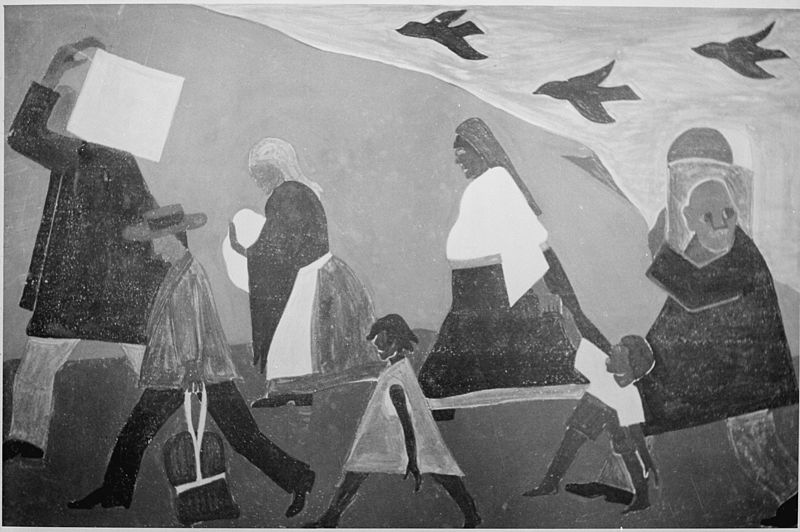 Douglass argued against poor Negroes leaving the South
Douglass argued against poor Negroes leaving the South
Jacob Lawrence was born September 7, 1917, in Atlantic City, New Jersey, where his parents had migrated from the rural south. They divorced in 1924.[2] His mother put him and his two younger siblings into foster care in Philadelphia. When he was 13, he and his siblings moved to New York City, where he reconnected with his mother in Harlem. Lawrence was introduced to art shortly after that when their mother enrolled him in after-school classes at an arts and crafts settlement house in Harlem, called Utopia Children’s Center, in an effort to keep him busy. The young Lawrence often drew patterns with crayons. In the beginning, he copied the patterns of his mother’s carpets.
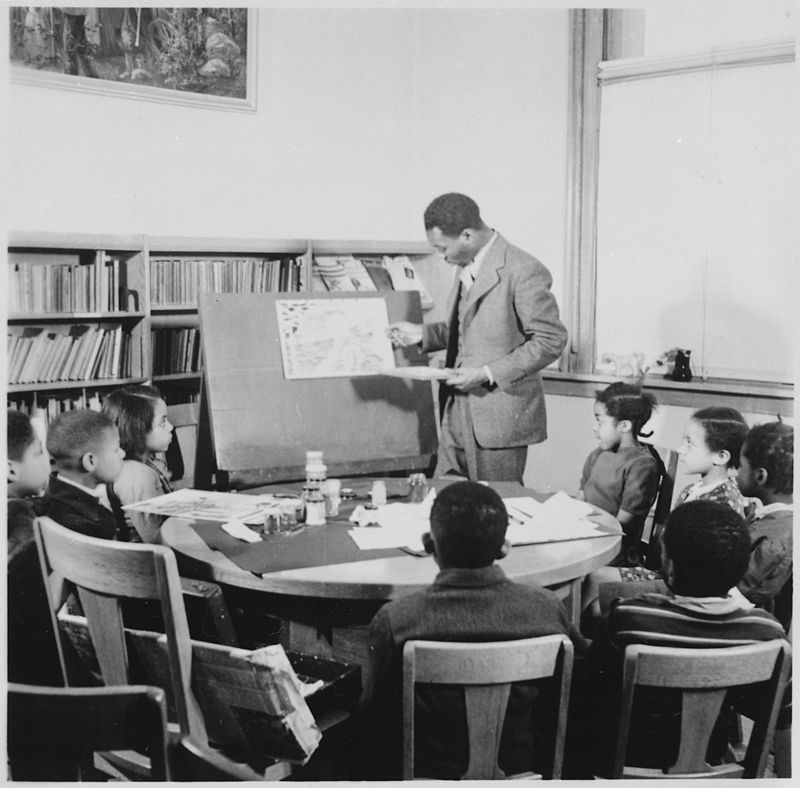 Lawrence teaching school children at the Abraham Lincoln School
Lawrence teaching school children at the Abraham Lincoln School
After dropping out of school at 16, Lawrence worked in a laundromat and a printing plant. He continued with art, attending classes at the Harlem Art Workshop, taught by the noted African-American artist Charles Alston. Alston urged him to attend the Harlem Community Art Center, led by the sculptor Augusta Savage. Savage secured a scholarship to the American Artists School for Lawrence and a paid position with the Works Progress Administration, established during the Great Depression by the administration of President Franklin D. Roosevelt. Lawrence continued his studies as well, working with Alston and Henry Bannarn, another Harlem Renaissance artist, in the Alston-Bannarn workshop. He also studied at Harlem Art Workshop in New York in 1937. Harlem provided crucial training for the majority of Black artists in the United States. Lawrence was one of the first artists trained in and by the African-American community in Harlem.[3] Throughout his lengthy artistic career, Lawrence concentrated on exploring the history and struggles of African Americans.
The “hard, bright, brittle” aspects of Harlem during the Great Depression inspired Lawrence as much as the colors, shapes, and patterns inside the homes of its residents. “Even in my mother’s home,” Lawrence told historian Paul Karlstrom, “people of my mother’s generation would decorate their homes in all sorts of color… so you’d think in terms of Matisse.”[4] He used water-based media throughout his career. Lawrence started to gain some notice for his dramatic and lively portrayals of both contemporary scenes of African-American urban life as well as historical events, all of which he depicted in crisp shapes, bright, clear colors, dynamic patterns, and through revealing posture and gestures.[2]
At the very start of his career he developed the approach that made his reputation and remained his touchstone: creating series of paintings that told a story or, less often, depicted many aspects of a subject. His first were biographical accounts of key figures of the African diaspora. He was just 21 years old when his series of 41 paintings of the Haitian general Toussaint L’Ouverture, who led the revolution of the slaves that eventually gained independence, was shown in an exhibit of African-American artists at the Baltimore Museum of Art. This was followed by a series of paintings of the lives of Harriet Tubman (1938–39) and Frederick Douglass (1939–40).
His teacher Charles Alston assesses Lawrence’s work in an essay for an exhibition at the Harlem YMCA 1938:[5]
Having thus far miraculously escaped the imprint of academic ideas and current vogues in art,… he has followed a course of development dictated by his own inner motivations… Working in the very limited medium of flat tempera he achieved a richness and brilliance of color harmonies both remarkable and exciting… Lawrence symbolizes more than anyone I know, the vitality, the seriousness and promise of a new and socially conscious generation of Negro artists.
On July 24, 1941, Lawrence married the painter Gwendolyn Knight, also a student of Savage. She helped prepare the gesso panels for his paintings and contributed to the captions for the paintings in his multi-painting works.[6]
The Migration Series[edit]
Lawrence completed the 60-panel set of narrative paintings entitled Migration of the Negro or And the Migrants Kept Coming,[7] now called the The Migration Series, in 1940–41. The series portrayed the Great Migration, when hundreds of thousands of African Americans moved from the rural South to the urban North after World War I. Because he was working in tempera, which dries rapidly, he planned all the paintings in advance and then applied a single color wherever he was using it across all the scenes to maintain tonal consistency. Only then did he proceed to the next color. The series was exhibited at the Downtown Gallery in Greenwich Village, which made him the first African-American artist represented by a New York gallery. This brought him national recognition.[8] Selections from this series were featured in a 1941 issue of Fortune. The entire series was purchased jointly and divided by the Phillips Collection in Washington, D.C., which holds the odd-numbered paintings, and New York’s Museum of Modern Art, which holds the even-numbered. His early work involved general depictions of everyday life in Harlem and also a major series dedicated to African-American history (1940–1941).
Another biographical series of twenty-two panels devoted to the abolitionist John Brown followed in 1941-42. When these pairings became too fragile to display, Lawrence, working on commission, recreated the paintings as a portfolio of silkscreen prints in 1977.[9]
In 1943, Howard Devree, writing in The New York Times, thought Lawrence in his next series of thirty images had “even more successfully concentrated his attention on the many-sided life of his people in Harlem”. He called the set “an amazing social document” and wrote: [10]
Lawrence’s color is fittingly vivid for his interpretations. A strong semi-abstract approach aids him in arriving at his basic or archetypal statements. Confronting this work one feels as if vouchsafed an extraordinary elemental experience. Lawrence has grown in his use of rhythm as well as in sheer design and fluency.
World War II[edit]
In October 1943, during the Second World War, Lawrence was drafted into the United States Coast Guard and served as a public affairs specialist with the first racially integrated crew on the USCGC Sea Cloud, under Carlton Skinner.[11] He continued to paint and sketch while in the Coast Guard, documenting the experience of war around the world. He produced 48 paintings during this time, all of which have been lost. He achieved the rank of petty officer third class.
Lost works[edit]
In October and November 1944, MOMA exhibited of all 60 migration panels plus 8 of paintings Lawrence created aboard the Sea Cloud. He posed, still in his uniform, in front of a sign that read: Jacob Lawrence, The Migration Series and Works Created in the US Coast Guard”. The Coast Guard sent the eight paintings to exhibits around the United States. In the disorder and personnel changes that came with demobilization at the end of the war they went missing.
Post-war[edit]
In 1945, he was awarded a fellowship in the fine arts by the Guggenheim Foundation.[12] In 1946, Josef Albers recruited Lawrence to join the faculty of the summer art program at Black Mountain College.[13]
Returning to New York, Lawrence continued to paint but grew depressed; in 1949, he checked himself into Hillside Hospital in Queens, where he remained for eleven months. Painting there, he produced his Hospital Series, works that were uncharacteristic of him in their focus of his subjects’ emotional states as an inpatient.
Between 1954 and 1956 Lawrence produced a 30-panel series called “Struggle: From the History of the American People” that depicted historical scenes from 1775 to 1817. The series, originally planned to include sixty panels, includes references to current events like the 1954 Army-McCarthy hearings, and they sometimes explore relatively obscure or neglected aspects of American history, like a woman, Margaret Cochran Corbin, in combat or the wall built by unseen enslaved Blacks that protected the American forces at the Battle of New Orleans.[14] Rather than traditional titles, Lawrence labeled each panel with a quote, either to add an individual voice to his work or inject weighted vocabulary. Patrick Henry’s speech, famous for the phrase “Give me liberty or give me death”, he captioned with a different passage: “Is life so dear, or peace so sweet, as to be purchased at the price of chains and slavery.” A panel showing Blacks fighting against the British is captioned with the words of a man who sued for emancipation from slavery in 1773: “We have no property! We have no wives! No children! We have no city! No country!”[15] Three panels (Panels 14, 20 and 29) are lost, and three others were only located in 2017, 2020, and 2021.[16] The fraught politics of the mid-1950s prevented the series from finding a museum purchaser, and the panels had been sold to a private collector who re-sold them as individual works.[17]
The Brooklyn Museum of Art mounted a retrospective exhibition of his work in 1960.[18]
Publications[edit]
Lawrence illustrated several works for children. Harriet and the Promised Land appeared in 1968 and used the series of paintings that told the story of Harriet Tubman.[19] It was listed as one of the year’s best illustrated books by The New York Times and praised by the Boston Globe: “The author’s artistic talents, sensitivity and insight into the black experience have resulted in a book that actually creates, within the reader, a spiritual experience.” Two similar volumes based on his John Brown and Great Migration series followed.[20] Lawrence created illustrations for a selection of 18 of Aesop’s Fables for Windmill Press in 1970, and the University of Washington Press published the full set of 23 tales in 1998.[21]
Teaching and late works[edit]
Lawrence taught at several schools after his first stint teaching at Black Mountain College, including the New School for Social Research, the Art Students League, Pratt Institute,[22][23] and the Skowhegan School.[24] He became a visiting artist at the University of Washington in 1970 and was professor of art there from 1971 to 1986.[18] He was graduate advisor there to lithographer and abstract painter James Claussen[25]
Shortly after moving to Washington state, Lawrence did a series of five paintings on the westward journey of African-American pioneer, George Washington Bush. These paintings are now in the collection of the State of Washington History Museum.[26]
He undertook several major commissions in this part of his career. In 1980, he completed Exploration, a 40-foot-long mural made of porcelain on steel, comprising a dozen panels devoted to academic endeavor. It was installed in Howard University’s Blackburn Center. The Washington Post described it as “enormously sophisticated yet wholly unpretentious ” and said:[27]
The colors are competely flat, but because the porcelain is layered, and because Lawrence here and there paints in strong black shawdows, his mural has the look of a rich relief. It is full of visual rhymes. The small scene of John Henry, the steel drivin’ man, in the final panel is echoed by an image of a sculptor in the art scene: He is hammering another spike, for quite different reasons, into a block of stone. This is not art that one tires of, for it is not the sort of work one can read at once.
Lawrence produced another series in 1983, eight screen prints called the Hiroshima Series. Commissioned to provide full-page illustrations for a new edition of a work of his choice, Lawrence chose John Hershey‘s Hiroshima (1946). He depicted in abstract visual language several survivors at the moment of the bombing in the midst of physical and emotional destruction.[7][28]
Lawrence’s painting Theater was commissioned by the University of Washington in 1985 and installed in the main lobby of the Meany Hall for the Performing Arts.[29]
Last years[edit]
The Whitney Museum of American Art produced an exhibition of Lawrence’s entire career in 1974, as did the Seattle Art Museum in 1986.[18]
In 1999, he and his wife established the Jacob and Gwendolyn Lawrence Foundation for the creation, presentation and study of American art, with a particular emphasis on work by African-American artists.[18] It represents their estates[30] and maintains a searchable archive of nearly a thousand images of their work.[31]
Lawrence continued to paint until a few weeks before his death from lung cancer on June 9, 2000, at the age of 82.[18] The New York Times described him as “one of America’s leading modern figurative painters” and “among the most impassioned visual chroniclers of the African-American experience.”[18] Shortly before his death he stated: “…for me, a painting should have three things: universality, clarity and strength. Clarity and strength so that it may be aesthetically good. Universality so that it may be understood by all men.”[32]
A retrospective exhibition of Lawrence’s work, planned before his death, opened at the Phillips Collection in May 2001 and travelled to the Whitney Museum of American Art, the Detroit Institute of Fine Arts, the Los Angeles County Museum of Art, and the Museum of Fine Arts, Houston.[33] The exhibit was meant to coincide with the publication of Jacob Lawrence: Paintings, Drawings, and Murals (1935-1999), A Catalogue Raisonne.[34] His last commissioned public work, the mosaic mural New York in Transit made of Murano glass was installed in October 2001 in the Times Square subway station in New York City.[35][36]
His wife, Gwendolyn Knight, survived him and died in 2005 at the age of 91.[37]
Recognition[edit]
- 1945: Awarded a fellowship in the fine arts by the Guggenheim Foundation[12]
- 1970: Awarded the Spingarn Medalby the NAACP for his outstanding achievements[38]
- 1971: Elected an associate member of the National Academy of Design
- 1978: Elected a member of the National Academy of Design
- 1983: Elected a member of the American Academy of Arts and Letters
- 1990: Awarded the U.S. National Medal of Arts
- 1995: Elected a fellow of the American Academy of Arts and Sciences[39]
- 1996: The Meadows School of the Arts at Southern Methodist Universityawarded him the Algur H. Meadows Award for Excellence.[40]
- 1998: Awarded the highest honor of Washington state, The Washington Medal of Merit
The eighteen institutions that awarded Lawrence honorary degrees include Harvard University, Yale University, Howard University, Amherst College, and New York University.[18]
Legacy[edit]
- The Seattle Art Museumoffers the Gwendolyn Knight and Jacob Lawrence Fellowship, a $10,000 award to “individuals whose original work reflects the Lawrences’ concern with artistic excellence, education, mentorship and scholarship within the cultural contexts and value systems that informed their work and the work of other artists of color.”[41]
- The Jacob Lawrence Gallery at the University of Washington School of Art + Art History + Designoffers an annual Jacob Lawrence Legacy Residency.[42]
His work is in the permanent collections of numerous museums, including the British Museum,[43] the Metropolitan Museum of Art, the Smithsonian American Art Museum,[44] the Museum of Modern Art, the Whitney Museum, the Phillips Collection, the Brooklyn Museum, the National Gallery of Art[45] and Reynolda House Museum of American Art, the Art Institute Chicago, the Madison Museum of Contemporary Art, the Kalamazoo Institute of Arts, the Minneapolis Institute of Art, the Minnesota Museum of American Art, the Savannah College of Art and Design Museum, the Seattle Art Museum, the Birmingham Museum of Art,[46] the Indianapolis Museum of Art,[47] the University of Michigan Museum of Art,[48] the North Carolina Museum of Art,[49] the Princeton University Art Museum,[50] the Musei Vaticani,[51] the Paul G. Allen School of Computer Science and Engineering,[52] the Pennsylvania Academy of the Fine Arts,[53] the Saint Louis Art Museum,[54] the Virginia Museum of Fine Arts,[55] the Studio Museum in Harlem,[56] the Philadelphia Museum of Art,[57] the Portland Art Museum,[58] the Hudson River Museum,[59] and The Walker Art Center in Minneapolis.
In May 2007, the White House Historical Association purchased Lawrence’s The Builders (1947) at auction for $2.5 million. The painting has hung in the White House Green Room since 2009.[60][61]
See also[edit]
Jacob Lawrence’s Artwork

Egg tempera on hardboard
12 × 16 in. (30.5 × 40.6 cm)
The Metropolitan Museum of Art
© The Jacob and Gwendolyn Lawrence Foundation, Seattle / Artists Rights Society (ARS), New York.
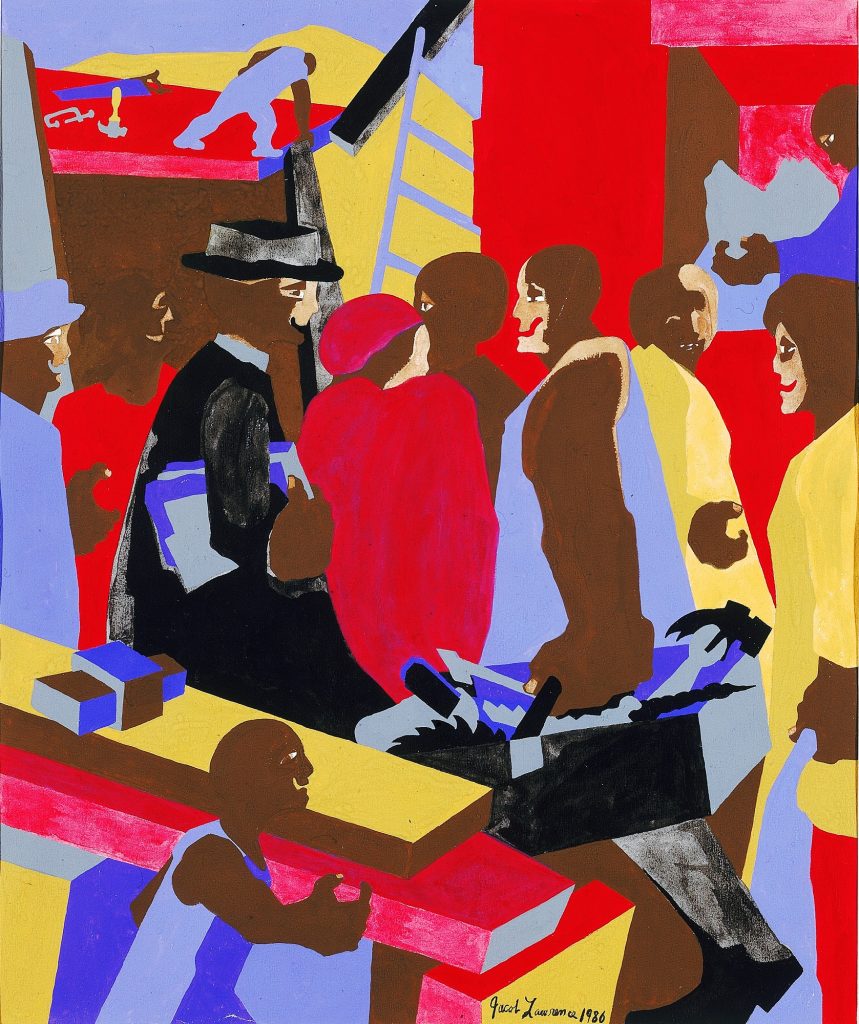
Jacob Lawrence’s Artwork

Coast Guardsman Jacob Lawrence, with his paintings at the Institute of Modern Art in Boston in 1945. During World War 2, Lawrence served with the first racially integrated crew on the USCGC Sea Cloud, under Carlton Skinner. He continued to paint and sketch while in the Coast Guard.
Historical Collection
Jacob Lawrence and his Artwork
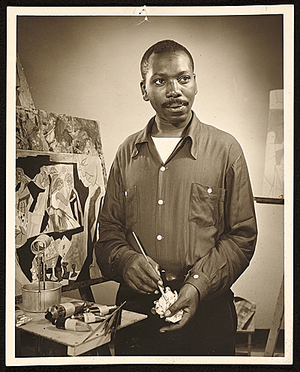
Jacob Lawrence and his Artwork

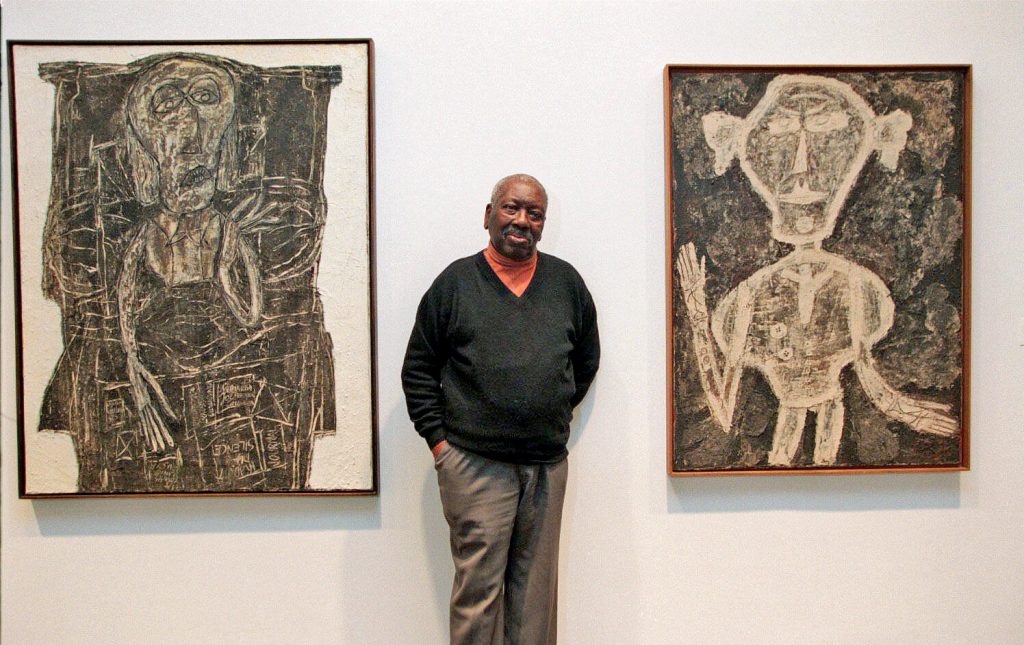
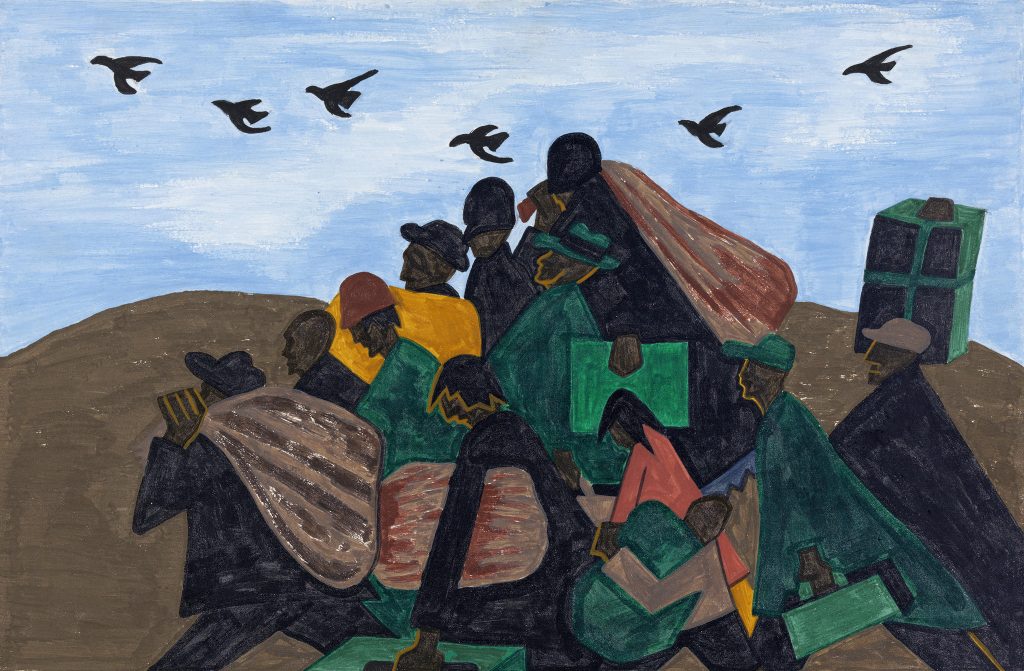
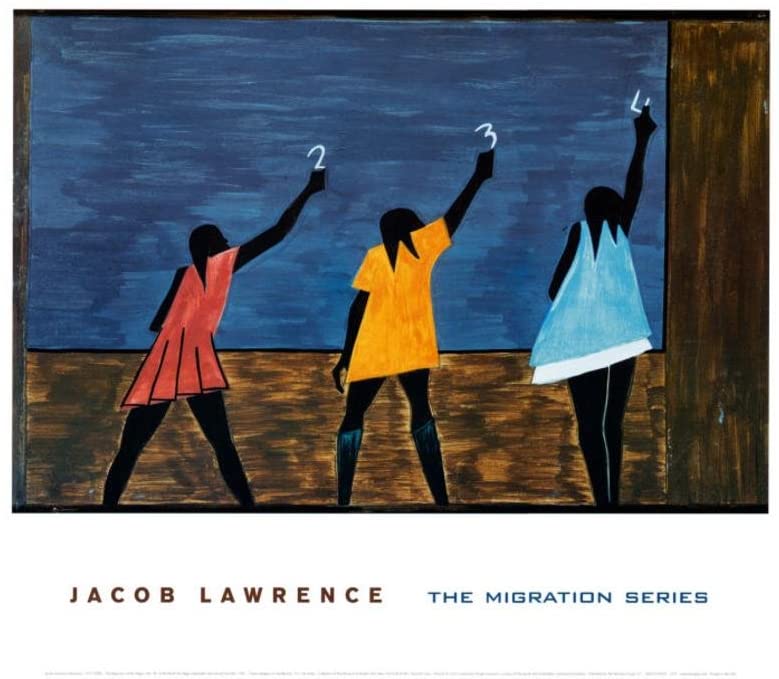
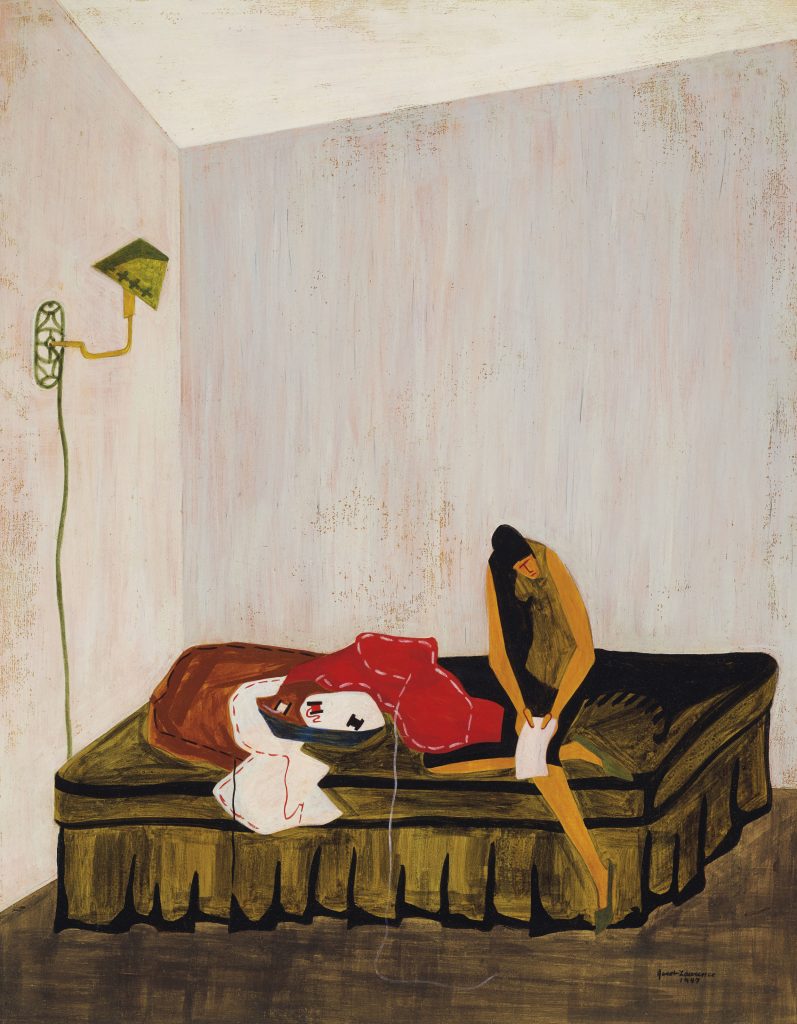
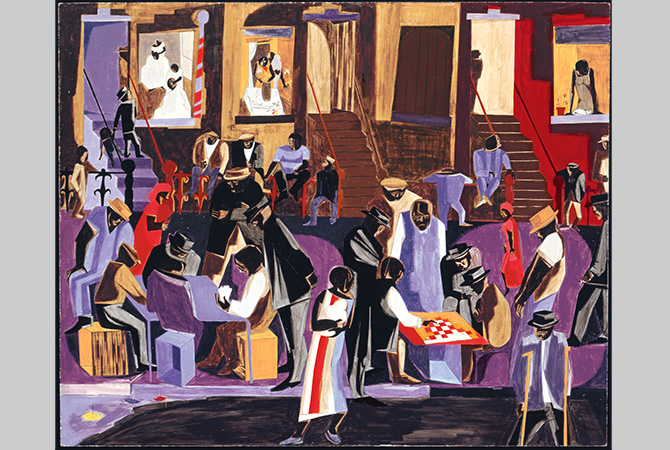








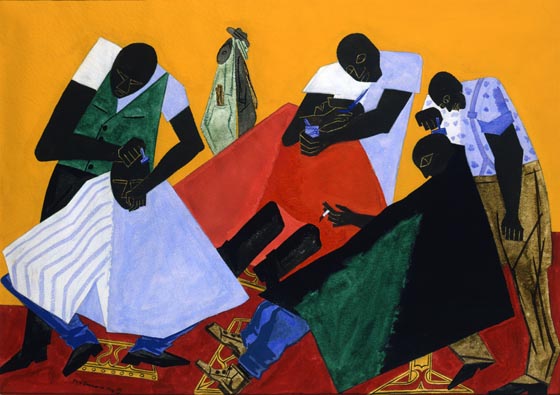
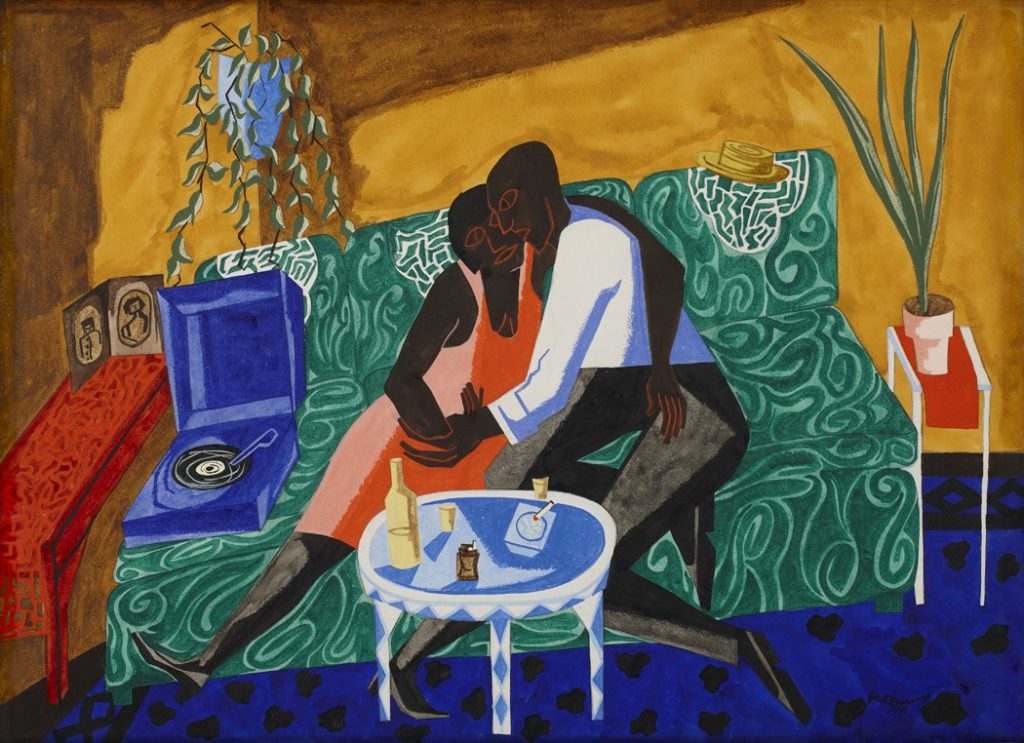


Leave a Reply